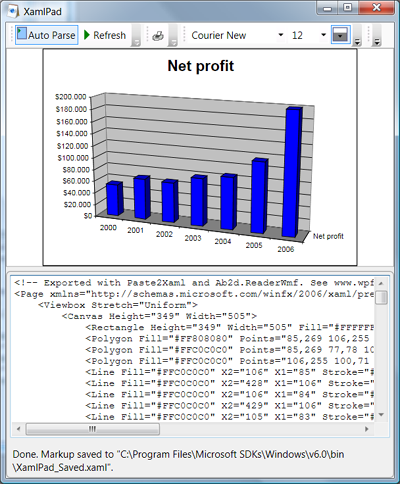-
2022:图元文件转换为Xaml||Paste2Xaml & ReaderWmf
Paste2Xaml & ReaderWmf--AB4D: Professional tools for 2D and 3D graphics for .Net applications
Import metafiles or copy graphics from
almost any application into xaml.

Paste2Xaml - convert clipboard and metafiles into xaml
Paste2Xaml is a WPF application that can read Windows metafiles (wmf), Enhanced Metafiles (emf) or get matafile objects from clipboard and can convert them into XAML. It is possible to export XAML for WPF, Silverlight, Windows Phone and Windows Store apps.
Paste2Xaml is using the Ab2d.ReaderWmf library that imports metafiles and can be also used in your applications.
Paste2Xaml Screenshots

Main Paste2Xaml window - a Power Point slide has been pasted to the Paste2Xaml application (showing as WPF elements).
Export Dialog - showing the xaml text and all the export options for a metafile. It is possible to export xaml for WPF, Silverlight, Windows Phone and Windows Store apps. It is also possible to export to Enhanced Metafiles (emf) - useful for saving clipboard data that can be later opened with Ab2d.ReaderWmf.
The objects from metafile can be exported as Shapes or as Geometries. Geometries export provide additional options to optimize for better performance and lower memory usage.
The graph from Microsoft Excel 2003 shown in XamlPad.
The following screenshot is showing Paste2Xaml with opened metafile that was created in AutoCad:
Screenshots of sample metafiles
The following images show screenshots of metafiles converted to XAML and show in IE (click on image to see it in full size):

Word art from Microsoft Word 2003
Formatted cells from Microsoft Excel 2007
Calendar created in Microsoft Visio 2003
Database schema created in Microsoft Visio 2003
Meeting Room schema created in Microsoft Visio 2003
Electrical equipment schema created in Microsoft Visio 2003
Brainstorm diagram created in Microsoft Visio 2003
Sample from Microsoft Office free Clip Arts
Sample from Microsoft Office free Clip Arts
Sample from Microsoft Office free Clip Arts
Sample from Microsoft Office free Clip Arts
Sample from Microsoft Office free Clip ArtsResourceDictionaryWriter
With Ab2d.ReaderWmf library it is possible to build ResourceDictionares from metafiles. This means all metafiles are converted into xaml which makes them much more efficient and easier to use.
To make building ResourceDictionares there is a ResourceDictionaryWriter sample application that is available with full source code so it can be fully customized. The following screenshot shows ResourceDictionaryWriter application with three metafiles added to the ResourceDictionary (xaml of ResourceDictionary can be seen on the right):

-
相关阅读:
一周热门|比GPT-4强100倍,OpenAI有望年底发布GPT-Next;1个GPU,1分钟,16K图像
JAVA接入OPC DA2.0详细流程
智慧安防解决方案-最新全套文件
对于 CRC 校验的 学习笔记
【合集】Redis——Redis的入门到进阶 & 结合实际场景的Redis的应用
120.三角形最小路径和
mysql倒序查询
MySQL-FlinkCDC-Hudi实时入湖
【毕业设计】基于单片机的智能鱼缸系统设计与实现 - 嵌入式 物联网 stm32 c51
this理解不到位,导致十一点半还在改bug
- 原文地址:https://blog.csdn.net/john_dwh/article/details/127889516